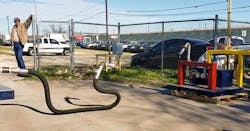Smart-Hose Technologies announces exception granted by Railroad Commission of Texas
Smart-Hose® Technologies has been granted an exception from the Railroad Commission of Texas (RRCT) LP-Gas Safety Rule Section 9.143(d)(7)(E)(i-ii) which mandates a 12-inch schedule 80 riser pipe be used for product transfer at bulk-head applications. The exception allows LPG bulk head transfer applications to use the Smart-Hose Break-Away coupler as an alternative. The Smart-Hose Break-Away coupler is designed with an engineered break point located between two swing check valves. In the event of a pull-away, the Smart-Hose Break-Away coupler would automatically shut off at both the bulk-head and tank truck side. This exception improves the safety of product transfers at bulk-head applications.
Designed as a passive safety device, the Smart-Hose Break-Away coupler requires no human intervention to activate. The coupler reduces plant closures, repair of plant facilities, and helps prevent increased insurance premiums due to pull-away instances. Both check valves are designed to close simultaneously. Product flow instantly shuts down in both directions in the event of a pull-away.

